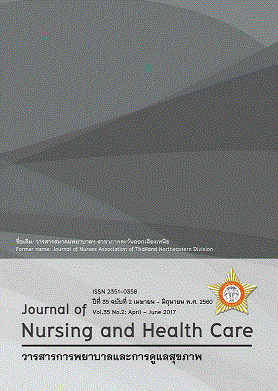ผลของโปรแกรมการปรับเปลี่ยนความเชื่อของสตรีกลุ่มเสี่ยงและสมาชิกครอบครัวต่อความตั้งใจในการตรวจคัดกรองและการมาตรวจคัดกรองมะเร็งปากมดลูก Effects of Changing Belief Program on Women at Risk and Family Members on Intention and Participation in Cervical Cancer
คำสำคัญ:
การปรับเปลี่ยนความเชื่อ ความตั้งใจ สตรีกลุ่มเสี่ยง การตรวจคัดกรองมะเร็งปากมดลูกChanging Belief, Intention, Women at risk, Cervical cancer screening.บทคัดย่อ
บทคัดย่อ
การวิจัยกึ่งทดลองครั้งนี้ มีวัตถุประสงค์เพื่อศึกษาผลของโปรแกรมการปรับเปลี่ยนความเชื่อของสตรีกลุ่มเสี่ยงและสมาชิกครอบครัวต่อความตั้งใจในการตรวจคัดกรองและการมาตรวจคัดกรองมะเร็งปากมดลูก กลุ่มตัวอย่างเป็นสตรีกลุ่มเสี่ยงที่มีอายุระหว่าง 30 – 60 ปี อาศัยอยู่ในเขตอำเภอสว่างวีระวงศ์ จังหวัดอุบลราชธานี จำนวน 60 ครอบครัว เลือกกลุ่มตัวอย่างด้วยวิธีการสุ่มตัวอย่างแบบหลายขั้นตอน และเลือกเข้ากลุ่มกลุ่มทดลองและกลุ่มควบคุม กลุ่มละ 30 ครอบครัว โดยกลุ่มทดลองได้รับโปรแกรมการปรับเปลี่ยนความเชื่อของสตรีกลุ่มเสี่ยงและสมาชิกครอบครัวที่ผู้วิจัยได้สร้างขึ้นจากรูปแบบความเชื่อความเจ็บป่วย แนวคิดด้านความตั้งใจ และแนวคิดรูปแบบความเชื่อด้านสุขภาพ ส่วนกลุ่มควบคุมได้รับการดูแลตามปกติจากเจ้าหน้าที่ประจำโรงพยาบาลส่งเสริมสุขภาพตำบล สถิติที่ใช้คือ จำนวน ร้อยละ Paired t-test Independent t – test และ Chi-square test
ผลการวิจัยพบว่า 1) กลุ่มทดลองที่ได้รับโปรแกรมการปรับเปลี่ยนความเชื่อมีค่าเฉลี่ยคะแนนความตั้งใจในการมาตรวจคัดกรองมะเร็งปากมดลูกที่สูงขึ้นอย่างมีนัยสำคัญทางสถิติ (t= 29.57, p < 0.001) 2) ผลการเปรียบค่าเฉลี่ยคะแนนความตั้งใจในการมาตรวจคัดกรองมะเร็งปากมดลูกของกลุ่มทดลองสูงกว่ากลุ่มควบคุมอย่างมีนัยสำคัญทางสถิติ (t= 29.57, p < 0.001) และ 3) กลุ่มทดลองมีจำนวนคนมาตรวจคัดกรองมะเร็งปากมดลูกมากกว่ากลุ่มควบคุมอย่างมีนัยสำคัญทางสถิติ (x2= 9.205, p < 0.001)
Abstract
The purpose of this quasi -experimental research was to examine the effect of changing belief of women at risk and family members on intention to and participation in cervical cancer screening. Sample consisted of 60 married women at risk for cervical cancer and family members aged 30 years to 60 years who lived in Sawangweerawong District, Ubonratchatani. Multi-stage cluster sampling was performed to recruit sample into the experimental and control group. Thirty women at risk and family members of the experimental group participated in the changing belief program and thirty women at risk and family members of the control group received regular care. Statistical analysis included t-test, pair d t-test and Chi-square test
The results showed that: 1) The experimental group receiving an application to modify the beliefs had significantly increase intention to screen for cervical cancer score (t = 29.57, p <0. 001). 2) The experimental group had significantly higher intention to screen for cervical cancer score, compared to those in the control group (t = 29.57, p <0.001). 3) The experimental group had significantly higher number of women screened for cervical cancer compared to the control group (x2 = 9.205, p <0.001)


